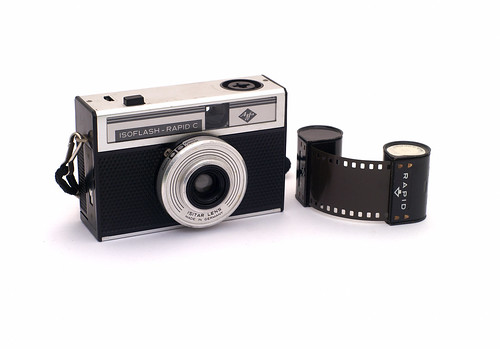Difference between revisions of "Isoflash-Rapid C"
m (Agfa Isoflash-Rapid I moved to Agfa Isoflash-Rapid C: wrong name) |
m |
||
| Line 6: | Line 6: | ||
}} | }} | ||
| − | The '''Agfa Isoflash-Rapid | + | The '''Agfa Isoflash-Rapid C''' was manufactured around 1966 by Agfa Camera-Werk in Munich, Germany. It was made for Agfa's own film system for 24×24mm exposures, the ''Rapid'' film cartridges. The two-cartridge system simplified film load. The film end of the new cartridge has to be layed into the camera with the film reaching the opening of a second cartridge which winds up the exposed film. Then the camera has to be closed and can be used after winding up for the first exposure. |
The Isoflash-Rapid C was basically the Iso-Rapid C for distribution in the USA. It uses magicubes. It has an Isitar f/8.2 lens in a Parator shutter with two speeds: “Sunny” (1/80 sec) and “Shade/Cloudy” (1/40 sec). For firing the flash cubes the camera does use a battery that is well hidden behind the baseplate. | The Isoflash-Rapid C was basically the Iso-Rapid C for distribution in the USA. It uses magicubes. It has an Isitar f/8.2 lens in a Parator shutter with two speeds: “Sunny” (1/80 sec) and “Shade/Cloudy” (1/40 sec). For firing the flash cubes the camera does use a battery that is well hidden behind the baseplate. | ||
Revision as of 19:33, 30 December 2006

|
| camera with Rapid film |
The Agfa Isoflash-Rapid C was manufactured around 1966 by Agfa Camera-Werk in Munich, Germany. It was made for Agfa's own film system for 24×24mm exposures, the Rapid film cartridges. The two-cartridge system simplified film load. The film end of the new cartridge has to be layed into the camera with the film reaching the opening of a second cartridge which winds up the exposed film. Then the camera has to be closed and can be used after winding up for the first exposure.
The Isoflash-Rapid C was basically the Iso-Rapid C for distribution in the USA. It uses magicubes. It has an Isitar f/8.2 lens in a Parator shutter with two speeds: “Sunny” (1/80 sec) and “Shade/Cloudy” (1/40 sec). For firing the flash cubes the camera does use a battery that is well hidden behind the baseplate.